Date : December 5 - 6, 2019
Miyazaki Prefecture Press Tour -Yokagura passing on Japan’s myths and people using local resources to build a future-
post date : 2019.11.15
I. Takachiho: Yokagura in the Home of Myths, with One of Japan’s Most Beautiful Gorges
II. Community Businesses Creating Local Economic Cycles with a Global Perspective
III. Holy Site from Myth Where the “Sazare-ishi” Mentioned in the National Anthem Remain
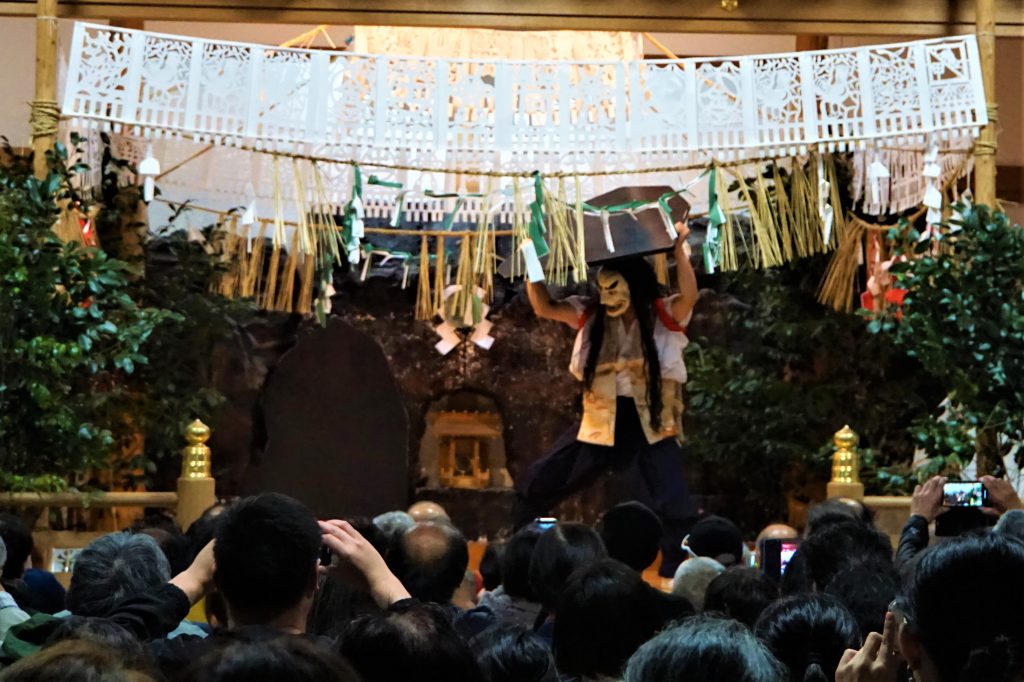
Miyazaki Prefecture, located in the southeast of Kyushu, is known as the birthplace of myths. In the Kojiki and Nihonshoki, Japan’s oldest historical books which were originally made over 1200 years ago, there are many myths and stories based in Miyazaki about the emperor and the gods giving birth to Japan.
Takachiho, in the northern end of the prefecture, is located in a harsh natural environment, surrounded by steep mountains. People living there worshipped the gods present in all things, living in harmony with nature in a unique lifestyle. The yokagura of Takachiho is both a ritual offered up to those gods which has been passed down over more than 800 years, and an important symbol that helps strengthen the bonds of the community, which has been designated as an Important Tangible Folk Cultural Property by the Japanese government. The tour will cover efforts by people to pass on their traditions and techniques to future generations, even as they face the issues of a declining birthrate and aging population which are common in rural Japan.
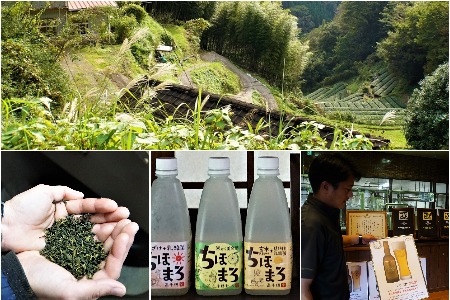
The north of Miyazaki Prefecture is also home to people seeking to solve regional issues by creating economic cycles within the region, through businesses using local specialties. The agriculture and forestry system there, which was recognized as a Globally Important Agricultural Heritage System, has been carried on to the modern day, and the tour will look at initiatives to increase production by using unique local resources such as terrace fields and tea along with the energy of youths and people who moved to the area. In addition to effective utilization of local specialties, there is a company aiming for global markets with craft beer which has incorporated the metalworking skills of local companies into its production process. The tour will cover efforts to expand local industries and pass them on from generation to generation, by combining them with new ideas and technologies.
I. Takachiho: Yokagura in the Home of Myths, with One of Japan’s Most Beautiful Gorges
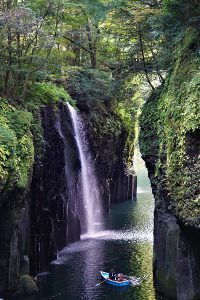
1. One of Japan’s Most Beautiful Gorges
<Takachiho Gorge>
Takachiho Gorge is known for being among the most impressive of Japan’s gorges. Pyroclastic flow from four eruptions by Mt. Aso from around 270,000 years ago cooled and hardened, and with erosion over the years became this gorge with columnar jointing. The gorge is designated as a Place of Scenic Beauty and as a Natural Monument, and Manai Falls is considered one of the 100 best waterfalls in Japan. This unique natural beauty, combined with the myths sleeping in the gorge and the mystique of the scenery, has enchanted many tourists from both Japan and abroad.
★The tour will walk along the gorge, guided by staff from the town and the Tourist Association.
2. Mythological Sites Appearing in Takachiho’s Yokagura
<Amano-Iwato Shrine/Amanoyasugawara>
Amano-Iwato Shrine worships the cave, Amano-Iwato, where the sun goddess Amaterasu is said to have hidden, a myth often portrayed in yokagura and written of in the Kojiki. The cave, which can be seen from the western shrine on the opposite bank of the river, is a sacred object and so filming and photography are not permitted.
Amanoyasugawara is another cave, where all the other gods are said to have gathered to discuss what to do about Amaterasu hiding. With the red torii gate in the darkness of the cave, and the countless piles of stones people have built as a form of making a wish, it truly does feel like something out of myth.
The yokagura which the tour will see will be about the Amano-Iwato myth.
★The head priest of the shrine will explain the connection between the Amano-Iwato myth and the shrine, and the tour will go see Amanoyasugawara, where filming and photography is permitted. Video and photos of the Amano-Iwato cave are not permitted.
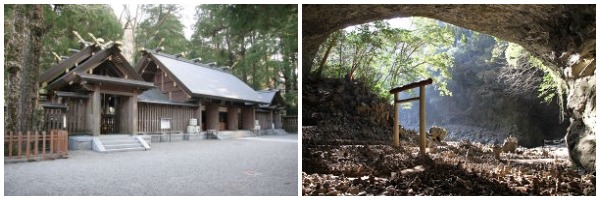
(Photos provided by Takachiho Town)
3. Passing on Kagura Masks and Their Techniques Through the Ages
<Amano-Iwato Kibori>
The kagura masks used in yokagura are made by a single business in town, with the family having passed down this traditional craft for generations. The artisans are Mr. Hiroaki Kudo and his son, Mr. Shogo Kudo. Using 20 different kinds of tools, it takes them two whole days to carve a mask from the thick wood. Kagura masks are made using paulownia wood, which is very delicate and difficult to work with, but with some masks made over 500 years ago still being used, it is said they can be used forever. Although domestic demand for the masks has been declining in recent years, they are popular as presents to people in other countries.
The father, Mr. Hiroaki, quit his job as an automobile mechanic when he married and began working as an artisan. After training by making statues of Buddha, he began making kagura masks 33 years ago. He is also carrying on the tradition of kagura as a dancer, and so is able to make masks from the perspective of a dancer.
★Mr. Hiroaki will explain about kagura masks and the tools used to make them, as well as giving a demonstration of carving.
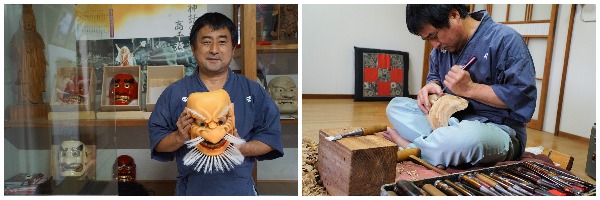
4. Takachiho’s Yokagura: Sacred Dances Passed Down Over 800 Years
<Yokagura>
The yokagura of Takachiho is designated as an Important Tangible Folk Cultural Property by the Japanese government. It is a religious ritual held all night long in each district in the town of Takachiho, every year between November and the following February. The kagura passed down in each district fulfill an important role in maintaining the solidarity of the local community. With effort put into both improving the dancers’ skills and training future generations, this traditional art form has been passed down over approximately 800 years.
In the Iwato district, the tradition of yokagura carries on, with the Gokamura Village Development Group playing a central role. In the past, each household took turns presenting yokagura, but in order to decrease the burden and create a central base for passing on the tradition, the group moved an old traditional house and renovated it to become the Kagura Hall. While faced with a declining birthrate and aging population, the dance that is the pride of the community will continue to be passed down through the generations, changed into a more sustainable form.
★The representative of the Gokamura Village Development Group will explain the tradition and dances of yokagura, followed by yokagura and local Takachiho cuisine. The yokagura presented will be about the Amano-Iwato myth, set in Amano-Iwato and Amanoyasugawara.

II. Community Businesses Creating Local Economic Cycles with a Global Perspective
1. Carrying on a Traditional Tea Production Technique, and Making Tea to Support the Future of the Region
<Miyazaki Sabo Co., Ltd.>
The Takachiho and Gokase region are the biggest producer in Japan of traditional kamairicha (pan-fried tea leaves), which was brought over from China in the 15th century. It used to be made throughout Japan, but as part of the trend to automation and mass production, sencha made by steaming the leaves became the most common. Kamairicha, which requires both time and expert skill to handle a kettle heated to 500 degrees Celsius, accounts for less than 1% of tea production in Japan. Nearly 90% of kamairicha is produced in this area.
Miyazaki Sabo has taken advantage of the cool temperatures of the region, to carry out cultivation with no pesticides or fertilizers for generations, producing around 100 kinds of tea including kamairicha. The company exports its products to the rest of Asia and to the West, particularly countries such as Germany, France, and Switzerland where interest in organic products is high. Most of the employees are in their 20s, 30s, or 40s, and there have been cases of young part-time staff who came to work in the busy season relocating to the town and getting married. Taking over farmland from the farmers in the village who have retired due to old age, the amount of tea produced is increasing every year.
★Company president Mr. Akira Miyazaki will speak about maintaining traditional tea production while bringing in people from outside and incorporating innovation, with the global market in mind. There will also be a demonstration of making kamairicha, and an opportunity to taste it.

2. Facing the Issues of a Declining Village and Reviving Terrace Fields to Build a Future
<Takachiho Muratabi Co., Ltd.>
In a village where over 80% of the population of around 100 people is 60 years old or older, Takachiho Muratabi makes and sells amazake (sweet, low/non-alcohol fermented rice drink) and other products, as well as running a hostel and restaurant. Of its 13 employees, 9 are 40 or younger, and this company of mainly young people and people from other areas has set a goal of achieving annual sales of 100 million yen, to support the future of the village. Creating employment and developing an economic cycle within the region has become a business model for farming villages throughout Japan facing the issues of population decline, a decreased birthrate, and an aging population.
Currently, Mr. Katsuhiko Saeki, the son-in-law of Takachiho Muratabi’s president, is in charge of production of amazake and other beverages. Having developed networks both within Japan and abroad, he has contributed to expanding the business. More than one person has joined the company after having been asked by Mr. Saeki.
Of the lactic acid bacteria beverages in Japan, Chihomaro amazake is said to have the most bacteria at one trillion per milliliter. It is popular with health-conscious consumers and is available at upscale grocery stores and natural food stores. Chihomaro is also exported overseas to China, Hong Kong, Singapore, Taiwan, and the UK, and with sales of 85 million yen in 2018, they are approaching their goal of 100 million yen. With their eyes on the global market, this farming village business from a village on the edge is continuing to grow.
★The tour will learn about efforts to build a sustainable future for the village working with youths and people who relocated from other areas, looking at amazake production and sales as well as the hostel, which foreign travelers also frequently use.

3. Creating World-class 100% Made in Miyazaki Beer Using Local Agriculture Products and Skills
<Miyazaki Hideji Beer Co., Ltd.>
Miyazaki Hideji Beer produces more than any other craft beer company in Kyushu, at around 200 kiloliters annually. From barley and hops production to using local agricultural specialties and culturing their own yeast, as well as using brewing tanks taking advantage of the metalworking skills of a local company, Miyazaki Hideji Beer has developed various methods to return profits to the community while working to make 100% Made in Miyazaki beer. In particular, the unique “100% Made in Nobeoka” brewing tank welded and polished by a company in Nobeoka with world-class metalworking skills has no bumps or unevenness in its interior, ensuring balanced fermentation and helping to improve the quality of the beer.
With a goal of “local production and global consumption,” Miyazaki Hideji Beer exports to countries around the world, such as the US. Their beer has won a variety of awards in craft beer contests throughout the world, such as the World Beer Awards which are held annually in the UK.
Currently, the company is working on cultivating hops, said to be impossible in Miyazaki Prefecture due to the heat, in order to achieve their goal of 100% Made in Miyazaki beer.
★The tour will learn about the company’s “local production and global consumption” concept, expanding the possibility of agriculture as a local craft beer company.

III. Holy Site from Myth Where the “Sazare-ishi” Mentioned in the National Anthem Remain
1. Oomi Shrine
Oomi Shrine, located on columnar jointed rock facing the Pacific Ocean, worships the sun goddess Amaterasu. It is said that when the grandson of Amaterasu, Ninigi-no-Mikoto, came here, he made a shrine to Amaterasu and prayed for peace.
The shrine grounds contain Japan’s largest collection of sazare-ishi. The sazare-ishi sung about in the national anthem Kimigayo are small rocks which collected at river mouths in the distant past, and over thousands of years mixed together with clay and sand to form into boulders. The Japanese rugby team came to visit this shrine and learn about the lyrics to Kimigayo, which is sung before matches, as a team-building activity, since over half the members of the team are from overseas.
★The head priest will provide an explanation, as the tour looks around the shrine and takes videos and photographs

Tour Itinerary
1. Date:December 5, 2019(Thu)~December 6(Fri)
<Day1:December 5(Thu)>
8:20 Leave Haneda Airport
10:15 Arrive at Kumamoto Airport
12:20~13:00 Lunch (in Takachiho)
13:10~14:10 Takachiho Gorge (One of Japan’s most beautiful gorges)
14:30~16:00 Amano-Iwato Shrine, Amanoyasugawara (Setting of myths)
16:10~17:10 Amano-Iwato Kibori (Kagura mask workshop)
17:30~19:30 Yokagura *Including dinner
20:00 Arrive at hotel
Stay overnight
<Day2:December 6 (Fri)>
8:00 Leave hotel
8:30~9:45 Miyazaki Sabo (Traditional tea production)
11:15~12:15 Takachiho Muratabi (Stimulating the local economy with amazake)
12:25~13:05 Lunch
14:35~15:35 Miyazaki Hideji Beer (Local craft beer production)
16:20~17:20 Oomi Shrine (Sazare-ishi)
19:15 Arrive at Miyazaki Airport
20:10 Leave Miyazaki Airport
21:45 Arrive at Haneda Airport
2. Qualification: Bearer of Gaimusho Press Registration Card
3. Cost: 15,000 yen per person including transportation accommodation and meal (FPCJ will later inform the participants of methods for payment, cancellation fee, etc.)
4. Participants: Limited to 10 applicants.
*If the number of applicants exceeds 10, an upper limit may be set on the number of participants from each country/region.
5. FPCJ Contact: Misaki Omiya(Ms.), Chika Yoshida(Ms.)
(Tel: 03-3501-5251, Email: sc@fpcjpn.or.jp)
6. Remarks:
(1) This tour is organized by Miyazaki Prefecture and planned and operated by the FPCJ.
(2) The schedule is subject to change without notice.
(3) This tour will require participants to bear part of the cost, but is not a profit-making venture.
(4) Neither the organizer nor FPCJ will be liable for any inconvenience, trouble or accidents that might occur during the tour.
(5)There may be some restrictions on photographing and filming at the tour sites. Please follow the instructions of the staff in charge.



